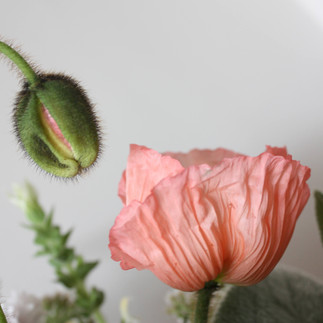Growing Icelandic Poppies
- Fuchsia Blooms
- Sep 25, 2023
- 3 min read
Updated: Feb 14, 2024

There is nothing more magical than the unfurling of an Icelandic Poppy with its crushed silk petals from that plump fury pod. Its one of my most requested flowers from florists and brides because of its sheer beauty and early blooms .
The are not for whimps or beginners but if you have been growing for a few seasons and have a coldframe or greenhouse then its worth trying your hand at growing Icelandic poppies. For amateur growers the Champagne Bubbles Variety is the best choice, it's ready available from many UK seed companies and very affordable with seeds for under £5 per packet. For more professional growers Colibri are the pinnacle of poppy growing......... more expensive - I paid £50 for my last packet I bought a few years ago, but they have much larger blooms. If you are just starting out then you may want to try with the cheaper seeds first to perfect your technique.
They are supposedly difficult to grow ( Mine germinated and I have viable flowers in my first season so it cant be that hard ! ) As long as you follow a few basic rules you should have at least some success. I find them much easier to grow than Lisianthus or Bells of Ireland.
Timing : Sown in late Summer/early autumn, September here in the UK, they will germinate quickly - within a few weeks. You may need a little bottom heat but I have successfully germinated then without it.
Compost: Use a sterile soil or seed compost as they are very prone to damping off. This will ensure that there are limited nutrients for funghi & bacteria to grow.
Quantity: Sow thinly - the seeds are microscopic and can be easily over crowded so sow seeds as thinly as possible to give them the room they need to grow and give good air circulation.
Trays: I sow my poppies in flat trays as I like to save as much space as possible. You can aso sow then straight into cell trays if you have the space.
Cover: They need light to germinate so a light cover of vermiculate is all that is needed. This is to stop the seeds from being washed away.
Watering: Water the soil BEFORE you sow the seeds, which stops the seeds from being washed away. Keep the soil most until germination then allow it to dry out a little between waterings otherwise the seedlings will suffer from damping off.
Potting on: They are slow growers and will stay quite small for a very long time, however pot them on into small cell trays as soon as they are big enough to handle and have developed true leaves.
Watering: Do not water the seedlings from overhead. They are still very delicate at this stage and will get easily damaged. Instead water from below and allow then to dry out a little between waterings to prevent damping off.
Overwintering: As the name kind of suggests Icelandic poppies like cool conditions, they can easily cope with a little frost so they can be grown on in an unheated greenhouse or coldframe for a few weeks until they are big enough to go into the ground. I often wait until late winter to plant them out into the ground and within a month or two the weather starts to warm a little and they will start to grow once more.
Planting out: An unheated greenhouse or polytunnel is ideal. They don't like heat so will happily flower early in the season. You can also plant them straight out into the ground and cover then with a low tunnel just for a little Snow and frost protection.
Cutting & Conditioning: Cut poppies in the cracking bud stage, before they unfurl. You will see just a tiny hint of coloured petal through a crack in the fury bud . I go out early in the morning to catch them, otherwise they will pop open in the morning sunshine. This prevents pollination so they will last longer in the vase, you can also sear the ends in boiling water and they will last around 5 days on the vase.
To learn more about how to grow cut flowers visit the growing guides from The Hampshire Seed Company











Comments